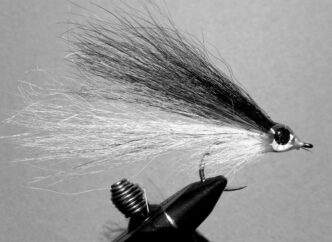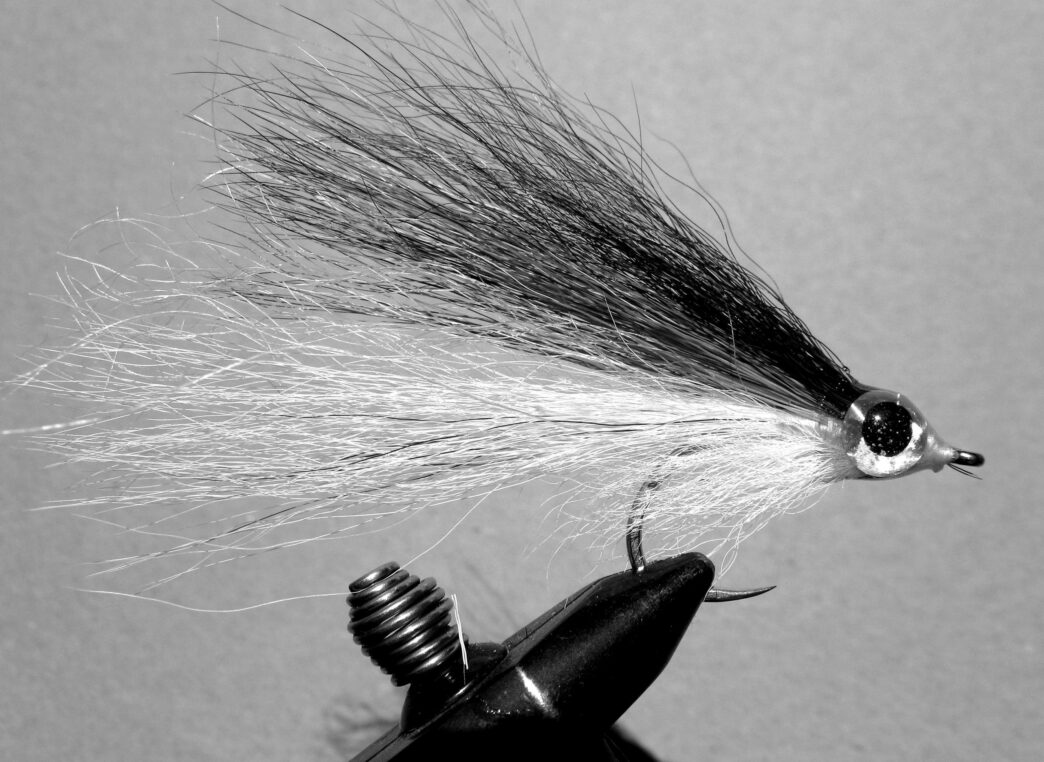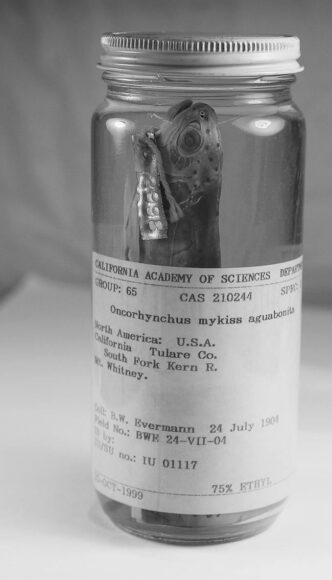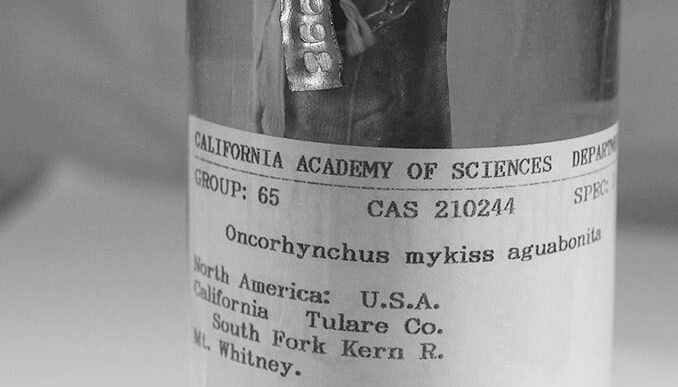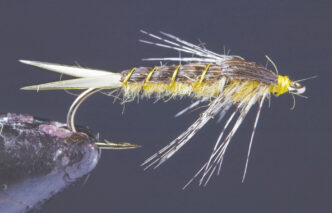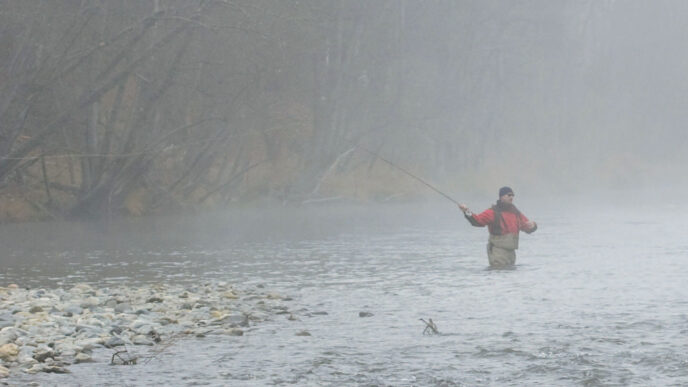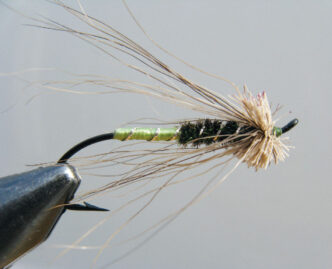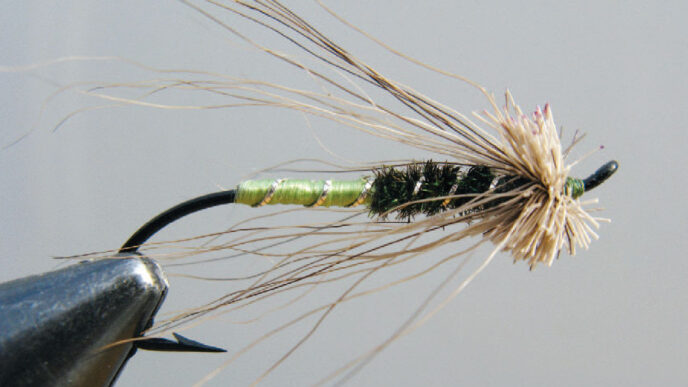The captain’s knot is worth learning. Tied a little like a Palomar Knot, a little like a Jansik Special, it ends up resembling a Perfection Loop from which you’ve dangled the fly. A lot of anglers today like their fly hanging from a loose loop, the idea, of course, being that you get more movement or action or simply a more realistic presentation out of your cast. The Captain’s Knot does all that, plus, it has the advantage of using, when tied right, very little tippet material.
But I use it because I believe in it.
Panga fishing in Baja, you’d better believe in your knots. A big part of bluewater fishing anywhere, in fact, is finding out, over and over again, the weak link in your system — very often a knot that fails. If a knot gives, you need to learn how to tie it correctly — or try something new.
Still, like a kid who gets to go fishing only a time or two a year, I never seem to remember how Valente and the rest of the Lucero captains hang the fly off the tippet — at least not until I return to Baja and get back into the panga groove. At the start of a trip, I always feel like I’m trying to catch up, figuring out my rods and lines and reels, some of which I still borrow each year, because, in case you haven’t noticed, this stuff is expensive — despite the economic drawdown.
One question, however, is why don’t I use the Captain’s Knot when I’m fishing for anything else — trout, or steelhead, or smallmouths, or . . . whatever. And that’s a really good question, an answer to which might go a long way in revealing aspects of my character that I think we should just stop fishing for right now.
I have my reasons.
Well, okay since I brought it up:
The reason I haven’t changed knots in my freshwater fishing is because I never change knots — or anything else in a system that already works.
Or, to put it another way, I believe in knots, like most things, as long as they don’t fail.
I told you an answer was going to reveal way too much about me.
But this isn’t an essay about knots, anyway. Instead, I’m trying to ease my way into the subject of flies, flies that work and flies that don’t work — or at least that don’t work as well as others — and especially flies tied for panga fishing in Baja, or probably anywhere in the ocean, as far as that goes, where the fish you’re fishing for feed on other fish.
In other words, this is about minnows.
Now, traditionally, nearly all baitfish patterns were referred to — either in name or as a style of fly — as minnows.
Even when the fly was created to imitate a sardine or herring or other type of baitfish, the fly pattern was still, essentially, a minnow. Mostly this meant that the fly in question wasn’t a crab or shrimp or some other crustacean pattern. Nor, significantly, a popper. Because there really aren’t a heck of a lot of different things that fish feed on in the ocean (I mean that at the class/order level of taxonomy), a minnow became a basic style of fly, almost like classifying a trout pattern as either a dry fly, a wet fly, a nymph, or a streamer.
A minnow or other named baitfish pattern shares certain fundamental properties, so that regardless of color, or materials, or size, or combinations thereof, you still have a minnow or minnowlike pattern — a fly that represents small, schooling fish that are preyed upon by the larger fish we’re trying to catch.
This is all pretty obvious — just as obvious, for almost anybody who thinks about such things, as how to fish such flies. If it’s a minnow, you throw it out in the water, try to make it look like it’s swimming (or maybe struggling to swim; or maybe dead, drifting, floating, or in some other fashion that makes it easy pickings) and hope the fish you’re after, or anything else, mistakes it for a baitfish and eats it.
This isn’t higher-order thinking.
Which should not suggest, either, that it’s necessarily easy.
There are a lot of things besides fooling fish with a minnow pattern that go into successful panga or bluewater fly fishing. I mentioned knots. I mentioned equipment. Of course, you have to know how to use this stuff to cast to fish, to hook, fight, and land them. These skills still probably don’t employ the most sophisticated aspects of our thinking. Neither, perhaps, does hunting fish in the wide reaches of the oceans, along beaches and channels and reefs, through the movement of the sea as current and waves and tides under the influence of weather, wind, seasons, the sun, and the moon. Very little in this equation, in fact, seems to demand much in the way of reason, articulation, the subtleties of language, or the precision of music or math.
But it’s still not easy.
Much of this fishing, I’d like to suggest, is more physical than mental, more intuitive, maybe even more emotional, than the logical problem-solving asked of us in trout fishing, say, as well as in our daily or income-earning lives.
A lot of times, out on the ocean blue, we just sort of seem to be winging it. And though that’s probably truer, as well, about our day-to-day lives than most of us care to admit, it should go a long way in explaining why many fly fishers can’t get enough of the sport I’m describing — that is, casting minnows to wild fish on the feed.
Many of us find it a relief sometimes to get out of our heads.
A minnow is just a minnow. Find fish. Throw it at them. If it’s right, it’ll work.
If not?
The fish will let you know.
Minnows, in whatever color, size, or configuration, are the quintessential style of saltwater fly because they work. Lefty’s Deceiver is a minnow pattern — which is probably sufficient evidence that a minnow will nearly always get you in the game. A Clouser, too, don’t forget, is actually a Clouser Minnow. Here on the West Coast, we also have, among many others, popular patterns such as Jeff Priest’s Sardina, Gary Bulla’s Tuna Tux, Larry Kurosaki’s Larry’s Minnow — all good flies, all available in a variety of sizes and colors, all essentially minnow patterns, all variations on the same theme.
And before Lefty’s Deceiver, there was Joe Brooks’s Blonde series, simple minnows you might want to look at — and maybe even tie a few and fish — the next time you’re wondering where to turn when faced with an overwhelming choice of different must-have minnows available, at five dollars a pop, from the catalog or from the fly shop nearest you.
Or even that really old saltwater classic, the Hy-Tie.
Trying one of these early minnow patterns is kind of like knotting on a simple nineteenth-century soft hackle that, surprise surprise, ends up fooling its fair share of trout while looking like nothing, exactly, on which you’ve ever seen trout dine.
Still, we all know that not just any minnow works. Not all the time. Not everywhere. Which is how this drifting essay returns to the thesis, introduced in the subject of knots, that the right thing is whatever works.
Failure to catch fish — or, better, to hook fish — is the primary evidence most of us use in determining whether or not things are working. (I’m talking here about angling — not the larger ramifications of what it means when we aren’t catching any fish at all in our lives.) Given the presence of fish, especially fish getting caught by others, when we don’t catch fish, the first thing we generally question is the fly.
Fling your minnow in the path of a charging roosterfish, watch the rooster rush the fly with its comb of spines erect and twitching, and now see said fish pivot like a barrel-racing pony and vanish in one instantaneous move, and you can be sure you’ll wonder if you have the right fly affixed to the end of your line.
This fly doesn’t work! goes the logic. Or: This fly sucks.
Hence, the change of fly. Hence, Somebody’s Minnow.
Now, most experienced fly fishers know that the fly is rarely the issue. Or they should know that. Casting and presenting the fly have a lot more to do with your success than your choice of fly.
But it’s easier to change flies than suddenly improve your game.
Still, when that roosterfish turns away, you know the right fly could have fooled him.
Or at least you think so. Somebody’s Minnow should work. And if it doesn’t?
You’ll probably want to try somebody else’s.
Somebody’s minnow, finally, is no different from anybody else’s minnow. — besides the fact that it’s tied to look like the baitfish you happen to be fishing around at any given place and time.
I’m reminded of the strange evolution of the Gold-ribbed Hare’s Ear in my trout fishing. Generally tied to represent a mayfly nymph, a Hare’s Ear didn’t become part of my regular lineup until I tied it in such a way that it looked more like certain caddis pupae common on the Deschute — at which point I started fooling so many fish with it that my pal Fred Trujillo dubbed it my Wild Hare. Later, after I had worked up a pattern to use as a mayfly nymph for some snooty brown trout east of home, I showed Fred the fly, claiming it was exactly the same as a Hare’s Ear, only tied out of completely different materials.
He knew exactly what I meant.
Somebody’s Minnow is just like that. It’s tied pretty much the same as every other minnow or baitfish pattern, except that you use certain materials unique to the pattern. Of course, color and size can change dramatically and you’re still tying a Somebody’s Minnow. In fact, whose minnow or baitfish pattern you choose to tie or use is hardly the point. What you want is a fly that swims through the water without any attributes that make fish refuse it.
That’s a little bit of a different way to look at the problem. And it’s not an original idea. Gary LaFontaine used to talk and write about it, the idea that fish are hardwired to say Yes and refuse our casts only when we cause them (poor presentation, something about our fly) to say No. Fish need to eat. That’s pretty much what they’re built to do — that and reproduce, which requires most of the energy from the food they consume. So it’s not as if fish, by nature, are picky eaters — nor do they adhere, like vegans or those of us on the latest health-enhancing diet, to a prescribed list of foodstuffs they will and won’t eat. Fish try to eat shiny metal lures, for crying out loud. You think that’s on the menu?
Yet every fly fisher is acutely aware that fish do say No — that, in fact, they often refuse the fly. Thank God for that, I say. Wouldn’t be much to think about (or talk or write about) if fish always obliged our devious ways.
When I fish with one of the Lucero captains, I let him look through my flies and select those he likes best. They’re nearly always Somebody’s Minnow. If I’m fishing with Valente, one of the senior captains, he lets me finish my Captain’s Knot, and then he swings the leader over the side of the panga and pulls the fly through the water, inspecting how it looks — the size, the shape, the color — whether it looks like the bait.
What a concept. Most significant, however, is what Valente doesn’t like to see — usually some kind of typical, flashy saltwater material that shows up in the water like bits of neon light. Look at baitfish in the water. They practically never look like that. Somebody’s Minnow is a simple, almost drab pattern tied with plain, natural materials — sort of like an outfit of a good pair of khaki chinos and a no-nonsense cotton dress shirt. I’m all for the new, the bright, the space-age, high-tech, next generation, kumquat-fusion DNA fiber for tying flies. But I like it more when Valente pulls my Somebody’s Minnow through the water alongside the panga, then turns to me, smiles, and says, “Ay, Papi.”
Somebody’s Minnow
Hook: Owner Aki, Trey Combs Big Game, or similar, size 2/0
Thread: White Danville 140-denier Flymaster
Tail: White bucktail
Body: Three layers: 1) White bucktail; 2) tan or light olive or dirty yellow bucktail or yak hair; 3) dark tan or dark olive bucktail
Belly: White calf tail
Eyes: 5/16-inch hologram, yellow or silver
Head: Five-minute epoxy
Tying Notes: There are a few things that make Somebody’s Minnow different from most other baitfish patterns. First, the absence of synthetic materials creates a fly that seems to blend into the water, rather than contrast with it. Also, by carefully selecting hair from different parts of a single bucktail or by using any sort of light-to-dark combination from different yak and bucktail colors, you create a fly with subtle color gradations, rather than abrupt, unnatural transitions. Most baitfish are pale below and, once you move above the lateral line, increasingly dark as you approach the dorsal fin.
A couple of other things: Calf tail is especially dense. After tying in the tail and the first layer of colored yak hair or bucktail, I turn the fly upside down and tie in a pinch of calf tail; I do the same thing just before tying in the darkest layer of hair on the back. But go light on the calf tail. Too much and the fly gets bulky and doesn’t look or swim right. Too long and the fly will foul.
Scott Sadil



